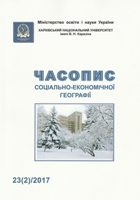Антропогенна інфраструктура як складова урбогеосистеми
Ключові слова:
урбогеосистема, антропогенна інфраструктура, урбосфера, урбосистеми, урбоекосистеми, класифікація антропогенної інфраструктури
Анотація
У статті детально розглядається сутність поняття «антропогенна інфраструктура» та її роль у складі урбогеосистем. Особливий наголос робиться на сучасних тенденціях щодо пришвидшення процесу урбанізації, підвищення ролі міського типу життя. Коротко описуються передумови виникнення урбосфери та причини виділення поняття «урбосистема». Розглянуто компонентну структуру таких систем. Наведено приклади впливу урбанізації на екосистеми, що стає передумовою для створення урбоекосистем. У теоретичному аспекті доведено, чому антропогенна інфраструктура є однією з найважливіших складових урбогеосистем. Проаналізовано декілька підходів щодо класифікації такої інфраструктури.Завантаження
##plugins.generic.usageStats.noStats##
Посилання
1. Kostrikov, S.V. (2014). Geoinfomatsiyne modelyuvanny prurodno-antropogennoho dovkillya. Naukova monografiya [Geoinformation modeling of natural and manmade environment. Scientific monograph]. Kharkiv, Vud-vo KhNU, 484.
2. Kostrikov, S.V., Chuiev O.S. (2015). Dvorivneva GIS-model dlya analizu urbogeosystem [Two-level GIS model for analysis of urboheosystems]. Region – 2015: Strategy of optimal development. Annual International Conference. Kharkiv, 20-22.
3. Kostrikov, S.V. (2014). Programne zabezpechennya GIS dlya LiDAR-technologii dustantsiynoho zonduvannya v tsilyakh analizu urbogeosystem [GIS software for LiDAR-technology for remote sensing for the purpose of analysis of urboheosystems]. Problemu bezperervnoi geografichnoi osvity i kartografii, 19, 45-52.
4. Likhacheva, E.A. et al. (1996). Gorod – ekosystema [City-Ecosystem]. Moscow: IGRAN, 336.
5. Mezentsev, K.V. (2012). Urbanizovani terytorii Ukrainy: prychyny i naslidky transformatsii u postradyanskyi period [Urbanized Territories of Ukraine: Causes and Consequences of Transformation in the Post-Soviet Period]. Sotsialno-geografichni vyklyky u Skhidno-Tsentralniy Evropi na pochatku XXI stolittya, Berehove, 310-317.
6. Reymers, N.F. (1990). Prirodopolzovanie. Slovar-spravochnik [Nature management. Dictionary-reference]. Moscow, Misl, 639.
7. Chuiev, O.S. (2017). Vykorystannya elektronnoho dovidnyka 2GIS ta GIS-platformy ArcGIS dlya doslidzhennya infrastruktury mista [Using the electronic directory of ArcGIS 2GIS and the GIS platform to explore the city's infrastructure]. Visnyk Khersonskoho derzhavnoho universyteu, seriya «Geografichni nauky», 7, 52-62.
8. Bailey, T., Fotheringham, S. (1994). A Review of Statistical Spatial Analysis in Geographical Information Systems. Spatial Analysis and GIS. Taylor & Francis. London, 13-44.
9. Berkowitz, A.R., Nilon, C.H., Hollweg, K.S. (Eds). (2005). Understanding Urban Ecosystems: A New Frontier for Science and Education. New York: Springer-Verlag, 523.
10. Bourne, L.S. (1997). Polarities of Structure and Change in Urban Systems: A Canadian Example. 43, 339-349.
11. Bourne, L.S., Simmons, J.W. (Editors) (1978). Systems of Cities: Readings on Structure, Growth, and Policy. Oxford: Oxford University Press, 565.
12. Boyce, D., Williams, H. (2015). Forecasting Urban Travel: Past, Present and Future Cheltenham – Northhampton: EE Publishing, 639.
13. Coffey, W.J., Shearmur, R.G. (1998). Factors and Correlates of Employment Growth in the Canadian Urban System, 1971-1991. Growth and Change. 29, 44-66.
14. Friedmann, J. (1996). The world city hypothesis. Development and Change. 27 (1), 69-83.
15. Kostrikov, S., Sehida, K. (2013). Human geography with geographical information systems. Human Geography journal, 15 (2), 39-47.
16. Simmons, J.W. (1978). The organization of the urban system. In: Bourne L.S., Simmons J.W. (eds), Systems of Cities: Readings on Structure, Growth, and Policy. Oxford: Oxford University Press, 61-69.
17. Wong, C, Baker, M, Webb, B, Hincks, S, Schulze-Baing, A. (2015). Mapping policies and programmes: The use of GIS to communicate spatial relationships in England. Environment and Planning B: Planning & Design.42(6), 1020-1039.
2. Kostrikov, S.V., Chuiev O.S. (2015). Dvorivneva GIS-model dlya analizu urbogeosystem [Two-level GIS model for analysis of urboheosystems]. Region – 2015: Strategy of optimal development. Annual International Conference. Kharkiv, 20-22.
3. Kostrikov, S.V. (2014). Programne zabezpechennya GIS dlya LiDAR-technologii dustantsiynoho zonduvannya v tsilyakh analizu urbogeosystem [GIS software for LiDAR-technology for remote sensing for the purpose of analysis of urboheosystems]. Problemu bezperervnoi geografichnoi osvity i kartografii, 19, 45-52.
4. Likhacheva, E.A. et al. (1996). Gorod – ekosystema [City-Ecosystem]. Moscow: IGRAN, 336.
5. Mezentsev, K.V. (2012). Urbanizovani terytorii Ukrainy: prychyny i naslidky transformatsii u postradyanskyi period [Urbanized Territories of Ukraine: Causes and Consequences of Transformation in the Post-Soviet Period]. Sotsialno-geografichni vyklyky u Skhidno-Tsentralniy Evropi na pochatku XXI stolittya, Berehove, 310-317.
6. Reymers, N.F. (1990). Prirodopolzovanie. Slovar-spravochnik [Nature management. Dictionary-reference]. Moscow, Misl, 639.
7. Chuiev, O.S. (2017). Vykorystannya elektronnoho dovidnyka 2GIS ta GIS-platformy ArcGIS dlya doslidzhennya infrastruktury mista [Using the electronic directory of ArcGIS 2GIS and the GIS platform to explore the city's infrastructure]. Visnyk Khersonskoho derzhavnoho universyteu, seriya «Geografichni nauky», 7, 52-62.
8. Bailey, T., Fotheringham, S. (1994). A Review of Statistical Spatial Analysis in Geographical Information Systems. Spatial Analysis and GIS. Taylor & Francis. London, 13-44.
9. Berkowitz, A.R., Nilon, C.H., Hollweg, K.S. (Eds). (2005). Understanding Urban Ecosystems: A New Frontier for Science and Education. New York: Springer-Verlag, 523.
10. Bourne, L.S. (1997). Polarities of Structure and Change in Urban Systems: A Canadian Example. 43, 339-349.
11. Bourne, L.S., Simmons, J.W. (Editors) (1978). Systems of Cities: Readings on Structure, Growth, and Policy. Oxford: Oxford University Press, 565.
12. Boyce, D., Williams, H. (2015). Forecasting Urban Travel: Past, Present and Future Cheltenham – Northhampton: EE Publishing, 639.
13. Coffey, W.J., Shearmur, R.G. (1998). Factors and Correlates of Employment Growth in the Canadian Urban System, 1971-1991. Growth and Change. 29, 44-66.
14. Friedmann, J. (1996). The world city hypothesis. Development and Change. 27 (1), 69-83.
15. Kostrikov, S., Sehida, K. (2013). Human geography with geographical information systems. Human Geography journal, 15 (2), 39-47.
16. Simmons, J.W. (1978). The organization of the urban system. In: Bourne L.S., Simmons J.W. (eds), Systems of Cities: Readings on Structure, Growth, and Policy. Oxford: Oxford University Press, 61-69.
17. Wong, C, Baker, M, Webb, B, Hincks, S, Schulze-Baing, A. (2015). Mapping policies and programmes: The use of GIS to communicate spatial relationships in England. Environment and Planning B: Planning & Design.42(6), 1020-1039.
Опубліковано
2017-11-30
Цитовано
Як цитувати
Чуєв, О. (2017). Антропогенна інфраструктура як складова урбогеосистеми. Часопис соціально-економічної географії, 23(2), 136-140. https://doi.org/10.26565/2076-1333-2017-23-20
Розділ
Дослідження молодих науковців
Авторське право (c) 2017 Олексій Чуєв

Цю роботу ліцензовано за Міжнародня ліцензія Creative Commons Attribution 4.0.




